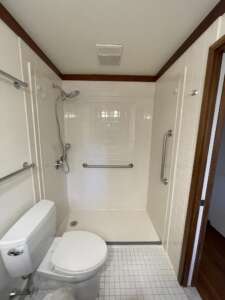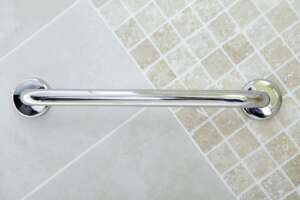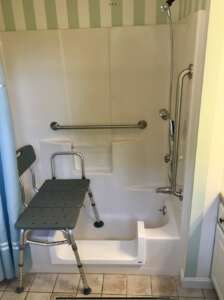Senior Friendly Bathroom Designs for Maximum Safety and Comfort
As we age, our needs and abilities change, making it essential to adapt our living spaces to ensure safety, comfort, and accessibility. Senior friendly bathroom designs cater to the unique needs of older adults, providing a safe and comfortable environment for daily routines. These bathrooms incorporate grab bars, non-slip flooring, and accessible layouts to enhance safety and independence. Creating a senior-friendly bathroom involves thoughtful design and practical modifications. From installing walk-in tubs and showers to adjusting sink heights and widening doorways, every detail matters. These changes not only improve safety but also promote ease of use, allowing seniors to maintain their dignity and independence. Let’s explore the key features and benefits of senior-friendly bathrooms, as well as provide tips and ideas for designing and renovating a bathroom to meet the needs of seniors. Whether you’re planning a complete bathroom renovation or making a few strategic upgrades, these insights will help you create a space that is both functional and comfortable.
Key Takeaways
- Safety features, such as grab bars, non-slip surfaces, and raised toilet seats, must be incorporated into a senior-friendly bathroom.
- A well-planned bathroom layout promotes ease of movement for seniors, incorporating accessibility features such as widened doorways and adjustable sink heights.
- Upgrading lighting solutions and selecting low-maintenance materials enhance safety and ease of upkeep in senior bathrooms.
Essential Features of a Senior Friendly Bathroom

Creating a senior-friendly bathroom starts with integrating essential safety features. A walk-in bathtub is crucial for improving safety and accessibility, allowing seniors to bathe comfortably without the risk of stepping over high tub walls. A hand-held shower head is another important feature, making bathing easier for seniors and individuals with mobility challenges by allowing them to wash difficult-to-reach areas without needing to stand. Grab bars are also a must-have, providing critical support and stability for seniors when moving around the bathroom. These bars should be strategically placed near the toilet and within the shower area to assist with standing and sitting.
Non-slip surfaces are also crucial in preventing falls. Bathrooms can quickly become slippery due to moisture, so incorporating non-slip mats, tiles, or flooring can significantly reduce the risk of accidents. Additionally, raised toilet seats and ADA-compliant accessories can dramatically improve the bathroom’s functionality. Elevating the height of toilets by a few inches helps seniors use the facilities comfortably and safely.
These essential features enhance bathroom safety and promote independence and ease of use for seniors. A well-designed and thoughtfully equipped bathroom can cater to the specific needs of older adults, ensuring their comfort and peace of mind.
Optimal Bathroom Layouts for Seniors
A senior-friendly bathroom’s layout is vital to its safety and usability. The bathroom door should have lever-style handles, open outwards to maximize space and safety, and have wide doorways to accommodate wheelchair access. For safe movement, sufficient space must be around the toilet, in shower stalls, and near cabinets. This is particularly important for seniors who use mobility aids like walkers or wheelchairs. Creating clear paths between fixtures ensures easy navigation and reduces the risk of tripping.
Key accessibility features, such as double sinks with wheelchair access and lowered sink heights, can enhance the bathroom’s functionality. Modifying the bathroom layout, including moving walls if necessary, can provide more room and facilitate easier movement for seniors.
These thoughtful design choices can transform an ordinary bathroom into a haven of safety and comfort for elderly individuals.
Safety Enhancements for Senior Bathrooms
Safety enhancements are critical in senior bathrooms. Non-slip mats in the shower and rugs can effectively prevent falls. Zero-entry showers, which eliminate the risk of tripping over thresholds, are another excellent feature for improving safety. Opting for non-slip tiles that combine style with extra grip is a wise choice.
Walk-in bathtubs, barrier-free showers, and curbless showers are designed to reduce fall risks and provide easier access to the bathing area. These features often include built-in seating and grab bars to ensure stability during use.
These safety enhancements significantly prevent accidents and ensure a safe bathing experience for seniors.
Installing Grab Bars

Installing grab bars is a straightforward yet highly effective way to enhance bathroom safety for seniors. To provide robust support, grab bars should be securely anchored, ideally to wall studs. If wall studs are unavailable, toggle bolts can also be used for reliable anchoring.
For optimal safety, grab bars should be installed in key areas, such as the shower and around the toilet. This simple addition can significantly reduce the risk of falls and provide essential support during movement.
Whether you install grab bars yourself or hire a professional, grab bars are an indispensable feature in any senior-friendly bathroom.
Non-Slip Flooring Options
Non-slip flooring is a crucial component of bathroom safety for seniors, especially when considering the bathroom floor. Materials like linoleum, rubber, and vinyl are highly recommended as they provide effective slip resistance. These options are not only safe but also easy to maintain, making them ideal for senior bathrooms.
Textured, non-slip tiles are another excellent choice, as they enhance safety by providing extra grip in wet conditions. In addition to these materials, incorporating non-slip mats can further prevent falls, especially in areas prone to water splashes, such as the shower and near the sink.
Choosing the right non-slip flooring options creates a safer and more secure environment for seniors.
Walk-In Showers and Tubs
Walk-in showers and tubs are designed to provide safer and more accessible bathing options for seniors. They often feature low thresholds or are curbless, making it easier for seniors with mobility issues to enter and exit the shower. These showers can also be paired with a hand held shower head, allowing seniors to bathe while seated, promoting independence and safety.
Walk-in tubs also offer significant safety benefits, including built-in seating and grab bars to ensure stability during use. They are designed to minimize the risk of falls by allowing seniors to step in and out easily.
Walk-in showers and tubs enhance the bathing experience and ensure a higher level of safety for seniors.
Barrier-Free Showers
The barrier-free shower line offers an ideal solution for overcoming the accessibility challenges posed by traditional curbed showers. These showers are crafted to support seniors in remaining at home by providing the most accessible and secure composite shower options available. Featuring low to no entry thresholds and fully plywood-backed walls, these showers ensure safety and ease of use. Designed as multiple-piece units, they are straightforward to install, allowing seniors to enjoy a hassle-free and safe bathing experience while preserving their independence.
Lighting Solutions for Senior Bathrooms
Good lighting is crucial for improving safety and visibility in the bathroom. LED recessed can lights are recommended for their brightness and energy efficiency. These lights can significantly enhance visibility, helping seniors see potential hazards like water splashes on the floor.
Motion-sensor lights and lighted switch plates are also excellent additions, enhancing accessibility and ease of use. Avoiding fixtures that cast shadows can prevent areas of reduced visibility, further increasing safety.
Contrasting colors in the design help those with vision impairments navigate the bathroom safely. By implementing these lighting solutions, you can create a well-lit and safe environment for seniors.
Seating and Support

Seating and support are crucial elements in a senior-friendly bathroom. Providing a safe and comfortable place to sit can help prevent falls and make daily routines more manageable. Incorporating features like shower seats, benches, and grab bars can significantly enhance bathroom safety and accessibility.
Shower Seats and Benches
Shower seats and benches are essential for seniors who need to sit while bathing. These seats can be installed in a walk-in shower or bathtub, providing a safe and comfortable place to sit. When choosing a shower seat or bench, consider the following factors:
- Height: The seat should be at a comfortable height to allow seniors to easily get in and out of the shower.
- Material: The seat should be made of a non-slip material, such as rubber or textured plastic, to prevent slipping and falling.
- Size: The seat should be large enough to accommodate the senior’s needs, but not so large that it obstructs the shower area.
- Installation: The seat should be installed securely to prevent it from tipping or moving during use.
Some popular options for shower seats and benches include:
- Fold-down seats: These seats can be folded up against the wall when not in use, providing more space in the shower area.
- Wall-mounted seats: These seats are mounted directly to the wall, providing a sturdy and secure place to sit.
- Free-standing seats: These seats are not attached to the wall, providing more flexibility in terms of placement and use.
Comfortable and Accessible Toilets
Comfort-height toilets are recommended for seniors as they enhance safety by providing a stable base, making it easier to sit and stand. Elevated toilet seats can significantly reduce strain on joints, particularly beneficial for seniors with arthritis. Replacing existing toilets with comfort-height versions or installing toilet seat risers are two effective options for increasing toilet height for seniors.
Bidets can also be valuable additions in senior bathroom remodels, as they make hygiene tasks easier and reduce the risk of instability and falls. Raised toilet seats with adjustable fixing brackets provide stability and security for seniors, especially when paired with an existing toilet.
Choosing the right toilet features enhances both comfort and accessibility in a senior-friendly bathroom.
Storage Solutions for Easy Access
Accessible storage solutions, including an accessible bathroom vanity, are essential in a senior-friendly bathroom. Frequently used items should be within arm’s reach to prevent loss of balance from stretching, bending, or walking across wet floors. Incorporating pull-out drawers allows seniors to access items easily without the need to reach deep into cabinets.
Open shelving or baskets help keep essential items within quick reach, promoting easier organization and access. Wall-mounted storage can optimize space and keep essential items within reach without taking up valuable floor space.
Implementing these storage solutions creates a more accessible and organized bathroom for seniors.
Low Maintenance Design Tips
Low maintenance design tips can help create a bathroom that is easy to clean and maintain. Using durable materials like quartz or solid surfaces for countertops can lessen cleaning efforts and resist staining. Regularly updating light fixtures and window coverings can also help maintain a well-lit and functional bathroom.
Choosing low maintenance materials and fixtures reduces the time and effort required for daily routines.
Cost-Effective Modifications
Cost-effective modifications can enhance senior bathroom safety without breaking the bank. Tub-to-shower conversions and grab bar installations are affordable upgrades that can significantly improve bathroom safety. Installing grab bars ranges from $100 to $500, making it an accessible option for most budgets.
Some healthcare companies may cover modifications like grab bars and higher toilets, but pre-approval is necessary. When choosing products for senior-friendly bathrooms, consider factors such as durability and ease of maintenance.
Focusing on cost-effective solutions creates a safe and functional bathroom for seniors without incurring excessive costs.
Putting it all Together
Creating a senior-friendly bathroom requires careful planning and consideration of the unique needs of older adults. Here are some tips for putting it all together:
- Assess the Existing Bathroom: Evaluate the existing bathroom to identify potential hazards and areas for improvement. Look for slippery surfaces, hard-to-reach fixtures, and inadequate lighting.
- Consult with a Professional: Consult with a professional contractor or designer who specializes in senior-friendly bathroom design. They can provide valuable insights and recommendations for creating a safe and accessible space.
- Choose Accessible Fixtures: Choose fixtures that are designed for accessibility, such as grab bars, walk-in tubs, and handheld showerheads. These fixtures provide essential support and make daily routines safer and more manageable.
- Consider Lighting: Consider installing light fixtures that provide bright and even lighting. Good lighting reduces the risk of falls and improves visibility, making it easier for seniors to navigate the bathroom.
- Add Non-Slip Surfaces: Add non-slip surfaces to the bathroom floor and shower or bathtub to reduce the risk of falls. Non-slip mats, tiles, and flooring materials can significantly enhance bathroom safety.
- Install a Walk-In Shower: Install a walk-in shower with a non-slip surface and handheld showerhead for easy access and comfort. Walk-in showers are designed to provide safer and more accessible bathing options for seniors.
- Use a Bathroom Renovation Checklist: Use a bathroom renovation checklist to ensure that all necessary features and fixtures are included in the design. This checklist can help you stay organized and ensure that no important details are overlooked.
By following these tips and considering the unique needs of older adults, you can create a senior-friendly bathroom that is safe, comfortable, and accessible. A well-designed bathroom can significantly enhance the quality of life for seniors, providing them with a space that meets their needs and promotes their independence.
Choosing the Right Contractor for Senior Bathroom Remodels
Choosing the right contractor for senior bathroom remodels is crucial for ensuring a successful bathroom renovation. Verify contractors’ credentials, including necessary licenses and certifications, to ensure they meet industry standards. Contractors with CAPS Certification are specifically trained in aging-in-place renovations, making them suitable for senior bathroom remodels.
Seek contractors who have extensive experience in creating accessible bathrooms tailored to seniors’ needs. Client testimonials and reviews can provide insight into a contractor’s reliability and craftsmanship, especially in accessibility projects.
Clear communication between homeowners and contractors is essential for addressing specific needs in accessible bathroom designs. A reputable contractor should provide a detailed and transparent estimate of the renovation costs to avoid unexpected expenses.
Let Oakley Home Access Make Your Bathroom Senior Friendly in New Haven, CT
Creating a senior-friendly bathroom involves thoughtful design and practical safety enhancements. At Oakley Home Access, our team of home safety experts is passionate about aging in place, fall prevention, and home accessibility in New Haven, CT. Owned and operated by registered, licensed CAPS-certified contractors and occupational therapists, we ensure that essential features like grab bars, non-slip surfaces, and raised toilet seats are expertly integrated for maximum safety and comfort.
By incorporating optimal layouts, accessibility improvements, and cost-effective modifications, we transform standard bathrooms into senior-friendly havens. Partnering with us ensures these changes are implemented effectively and efficiently, enhancing the quality of life for seniors.
Contact us today to discover how Oakley Home Access can help you create a bathroom that meets the practical needs of seniors while promoting their independence and well-being.
Frequently Asked Questions
Why are bathrooms considered tricky places for seniors?
Bathrooms are considered tricky places for seniors primarily because of the potential for slippery surfaces and hard floors that can pose a risk for falls. It is crucial to prioritize safety by implementing measures such as non-slip mats and grab bars.
What is the top non-fatal preventable injury in the United States?
Falling is the leading non-fatal preventable injury in the United States. Implementing safety measures can significantly reduce the risk of such injuries.
How does additional lighting improve bathroom safety for seniors?
Additional lighting significantly enhances visibility in the bathroom, allowing seniors to better detect potential hazards like wet floors. This simple upgrade can greatly reduce the risk of falls and improve overall safety.
What type of flooring is recommended for bathrooms designed for seniors?
Non-slip flooring, such as linoleum, rubber, or vinyl, is highly recommended for bathrooms designed for seniors to prevent slips and falls. Prioritizing safety is essential in creating a secure environment.
What is one benefit of remodeling a bathroom for seniors?
Remodeling a bathroom to enhance safety allows seniors to stay in their homes longer, offering peace of mind to both them and their families. This improvement can significantly contribute to their independence and well-being.
